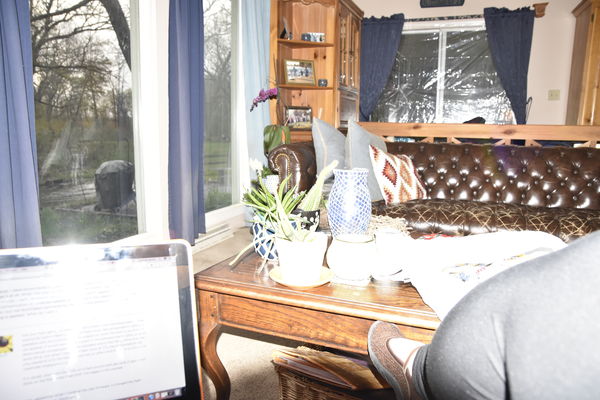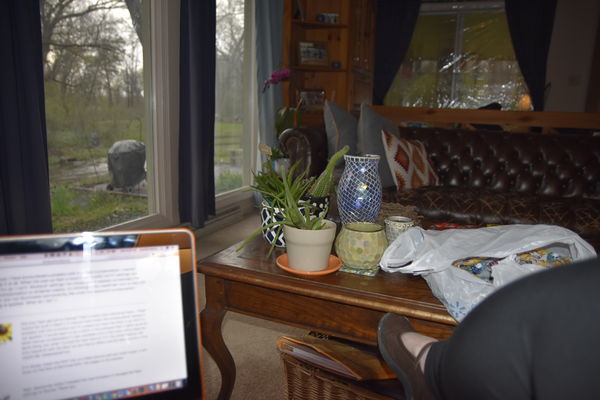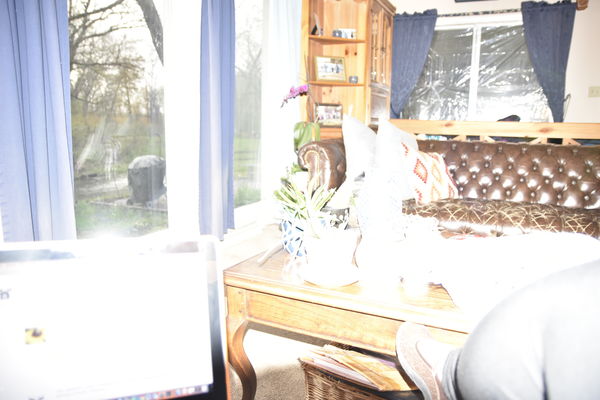What's going on here? Over-exposure.....but why?
May 1, 2019 21:00:49 #
Hi all:
I am learning so much from all of your topics and appreciate the chance to better my skills. Here's a question I have had. I have a Sigma 17 - 50 2.8 EX HSM. I find I continually get over-exposed shots and am trying to determine if the lens has an issue or it's just my lack of experience. I am shooting on a Nikon D3400 in this case.
Pic 3 here - my internal meter was telling me to add more light so I was about 2 stops too dark; exposure on Aperture priority 1/60th at f2.8; 800 ISO; 17 mm. Flash on.
Pic 1 here - my internal meter was telling me to add more light so I was about 1 stop too dark; exposure on Aperture priority 1/60th at f5.0; 800 ISP; 17 mm. Flash on.
Pic 2 here - auto settings which shoot on 1/200th at f2.8; 800 ISO; 17 mm. Flash on.
Obviously I was not trying to set a beautiful shot here - just the same one for comparison.
So it's not uncommon with this lens to get the example of picture #3 when shooting on A mode. I get I was wide open on the lens. I get the internal meter isn't always accurate. I get that manual is always better. Is this a need to drop the ISO? In A mode the shutter speed should be moving to compensate.
I am trying to figure out why this is happening consistently. I also see this often when I pop on my SB800 flash. I always thought the flash was having issues but now suspect the lens. Lens not in warranty as it was purchased from a friend (which invalidates the warranty). Last time I do that.
Appreciate your responses!
Cynthia
I am learning so much from all of your topics and appreciate the chance to better my skills. Here's a question I have had. I have a Sigma 17 - 50 2.8 EX HSM. I find I continually get over-exposed shots and am trying to determine if the lens has an issue or it's just my lack of experience. I am shooting on a Nikon D3400 in this case.
Pic 3 here - my internal meter was telling me to add more light so I was about 2 stops too dark; exposure on Aperture priority 1/60th at f2.8; 800 ISO; 17 mm. Flash on.
Pic 1 here - my internal meter was telling me to add more light so I was about 1 stop too dark; exposure on Aperture priority 1/60th at f5.0; 800 ISP; 17 mm. Flash on.
Pic 2 here - auto settings which shoot on 1/200th at f2.8; 800 ISO; 17 mm. Flash on.
Obviously I was not trying to set a beautiful shot here - just the same one for comparison.
So it's not uncommon with this lens to get the example of picture #3 when shooting on A mode. I get I was wide open on the lens. I get the internal meter isn't always accurate. I get that manual is always better. Is this a need to drop the ISO? In A mode the shutter speed should be moving to compensate.
I am trying to figure out why this is happening consistently. I also see this often when I pop on my SB800 flash. I always thought the flash was having issues but now suspect the lens. Lens not in warranty as it was purchased from a friend (which invalidates the warranty). Last time I do that.
Appreciate your responses!
Cynthia



May 1, 2019 21:12:06 #
Before I make any suggestions about using flash or flash modes, metering or metering modes ect.. I'm going to suggest getting the book Understanding Exposure IIIrd edition by Bryan Peterson. Until you understand how a camera reads and exposes for light all of the explanations in the world will only confuse you more. You can find the book used on the internet for 5 or $6 the best money you will ever spend. This will save you Hundreds of hours, please purchase and read.......P.S. it is not the lens.......
May 1, 2019 21:13:29 #
May 1, 2019 21:22:42 #
clherms wrote:
Hi all: br br I am learning so much from all of y... (show quote)
A camera will have several settings for exposure. One of them is a spot exposure where it only considers the brightness under the spot. Another uses a spot plus some consideration of the area around the spot and is more concerned with making a somewhat larger area have correct exposure. Another uses a yet wider area and figures out a suitable exposure setting based on this larger area, Also be aware that different camera may have more options than this.
It does not matter what the aperture is. Exposure will be balanced as per the mode you selected.
As for your images, you are using a narrow spot and the exposure is determined entirely by the brightness under the spot. Aim the camera onto something darker or lighter, and the whole image changes.
I use this spot method when I am only concerned about one thing in the image such as a bird, and I only care that the bird is exposed correctly.
As I care more about the whole image, I will pick an other mode.
I might add that knowing how this works, I rarely ever end up with an image that is exposed incorrectly. And this is with any lens I want to use and any shutter speed or aperture setting or any ISO that I choose to work with.
May 1, 2019 21:49:37 #
Set your camera up per Photo #2, tweek the exposure compensation dial. I’d try +1 and +2 and see how open the shadows are. Make a final adjustment. Done deal. Not worth all the anguish to be more precise when you can adjust further in post.
May 1, 2019 21:52:27 #
Thank you! I usually do adjust in post when this happens....am trying to understand it more. Appreciate your input!
May 1, 2019 21:52:41 #
Way too much range from dark to light for a single exposure. HDR (high dynamic range) is the technique needed here. Multiple exposures each exposed for the light level in a different part of the picture then blended by processing software to get an image with all parts properly exposed. UHH has an HDR section where you might find a lot of info and help.
https://www.uglyhedgehog.com/s-107-1.html
https://www.uglyhedgehog.com/s-107-1.html
May 1, 2019 22:02:14 #
Here's my WAG - well, more like WAGs about your pictures.
First off, your scene seems to be quite 'deep.' That is, from your camera & flash to the laptop computer may be 3ft, and to the blue mesh-wrapped candle seems about 5-6 ft, and then to the far wall with the T-shaped window is perhaps 15ft.
Due to the 'nature' of flash - actually the inverse square law - the farther away your subject, the less light actually reaches the subject from the flash. When the near-by laptop computer is properly exposed, there's just not enough light reaching the window, and vice-versa the laptop computer will be all blown out from over exposure when the 'far off' window is properly exposed.
Being able to remedy these types of scenes is a big part of the 'art' of flash photography.
Good luck with your photographic journey.
First off, your scene seems to be quite 'deep.' That is, from your camera & flash to the laptop computer may be 3ft, and to the blue mesh-wrapped candle seems about 5-6 ft, and then to the far wall with the T-shaped window is perhaps 15ft.
Due to the 'nature' of flash - actually the inverse square law - the farther away your subject, the less light actually reaches the subject from the flash. When the near-by laptop computer is properly exposed, there's just not enough light reaching the window, and vice-versa the laptop computer will be all blown out from over exposure when the 'far off' window is properly exposed.
Being able to remedy these types of scenes is a big part of the 'art' of flash photography.
Good luck with your photographic journey.
May 1, 2019 22:06:18 #
Okay this is what I was getting to try to understand...does the fact I am shooting at 17 mm play into this? As the scene is much wider than if I had focused down on something? I was focusing, in all three photos, on the pots on the edge of the table. Is this an issue that the flash is trying to "over read" my scene and doesn't know exactly what to do? Due to the depth of field varying and the width of the shot?
May 1, 2019 23:17:48 #
clherms wrote:
Okay this is what I was getting to try to understand...does the fact I am shooting at 17 mm play into this? As the scene is much wider than if I had focused down on something? I was focusing, in all three photos, on the pots on the edge of the table. Is this an issue that the flash is trying to "over read" my scene and doesn't know exactly what to do? Due to the depth of field varying and the width of the shot?
No, not really. Focus & exposure are 2 different aspects.
To 're-do' this photo, try getting a bit farther away, use a lens with a bit longer focal lenght, perhaps 50mm, so that there's not so much difference from flash to near subject and far subject.
If you can re compose your scene, so that the laptop is perhaps 10ft away and the curtain & window is perhaps 15ft away, then the exposures for both areas will be close enough that neither area is blown out or lost in inky shadows.
May 2, 2019 06:17:33 #
tcthome
Loc: NJ
Now that flash has been mentioned, on camera? , pointing straight at the scene? Try pointing it up at the ceiling, walls etc. Experiment , see if it helps. If it only happens with this lens , maybe the Nikon TTL isn't compatible with it. Anyway if you want to shoot with the flash/camera/lens set up the way you have it , try manual flash & turning the flash power down until you get the results you need. Probably some vids on U-TUBE on flash photography. Have fun , Tom
May 2, 2019 06:29:37 #
Your camera was in aperture priority for Pic 3 and Pic 1 and telling you to add more light. How did you then add more light? Did you use exposure compensation? You should have left that alone since the camera and flash will do TTL metering an instant before the shutter releases and it will adjust the flash output level.
You might check to see if there is some flash compensation dialed in. There may be some plus flash compensation dialed in and you don't know it.
What flash were you using? Was it the built-in flash or one on the hot shoe? If so, was the flash in TTL mode or manual? Was it a Nikon flash or third party?
Can you post those photo again and check the "store original" box? We will be able to see the metadata.
You might check to see if there is some flash compensation dialed in. There may be some plus flash compensation dialed in and you don't know it.
What flash were you using? Was it the built-in flash or one on the hot shoe? If so, was the flash in TTL mode or manual? Was it a Nikon flash or third party?
Can you post those photo again and check the "store original" box? We will be able to see the metadata.
May 2, 2019 07:01:08 #
clherms wrote:
Hi all: br br I am learning so much from all of y... (show quote)
Nothing wrong with your lens. I rarely, if ever purchase new gear myself. But I do buy from sellers where I have recourse - and always use paypal in the event of a dispute. Knock wood, I haven't had one that wasn't amicably and professionally resolved.
There are two things that will affect your exposure - the flash and it's system and the camera and it's system. When you use both together, the potential to get into the weeds is doubled.
A good way to resolve this is to set your camera to matrix metering, which evaluates the light reflectance for the entire scene and comes up with an exposure suggestion that will result in a reasonably well-exposed image, manual exposure and manual ISO, no flash. Take a picture of an average subject, preferably one with consistent lighting. Then switch the metering from matrix,
Then switch the metering to spot. Without taking a picture, just point the center focus point (which is also the metering point) around the scene, and look at how the camera responds to the darker and lighter parts of the scene. You may see a 2-5 stop difference between the darker and the lighter areas. You could average the readings yourself, or you could point the spot at the lightest area in which you wish to retain detail and add 1-2 stops of light to it. Either way, you will avoid the kind of severe overexposure you have in two of your images, but better, you will understand just how much exposure you can get away with before you lose the highlights.
Once you get comfortable with this, you can turn on the flash, and using no compensation shoot the scene. When you are shooting with flash, generally you select your aperture and ISO and the flash will adjust it's light output to provide a good exposure. You can then dial in negative flash compensation to diminish the effect of the flash from primary lighting to fill lighting. If you use manual flash, you can do that by adjusting the exposure in the camera from the shortest shutter speed, usually 1/200 or 1/250 sec for a scene that is entirely lit with the flash, to a much slower speed, like 1/30 or 1/60 to allow more ambient light into the scene.
This is very basic but necessary so that you can understand exposure and understand the interplay between flash and camera when you use the flash.
Or you can read about it in a book.

May 2, 2019 07:19:11 #
robertjerl wrote:
Way too much range from dark to light for a single exposure.
 My first thought. That's where post processing comes in handy. Especially shooting in raw, it's rather easy to compensate for light and dark areas.
My first thought. That's where post processing comes in handy. Especially shooting in raw, it's rather easy to compensate for light and dark areas.May 2, 2019 07:45:20 #
Try shutter priority with shutter speed of 1/125, auto ISO, no flash and see what you get. Look to see what ISO the camera wants to use and divide in half and turn flash on. Adjust ISO from there. I use flash on TTL with flash compensation at -1/3. Turning the flash power down -1/3 will help to stop the blown highlights in the photo. Pic 2 is fairly close, if you slow the shutter down some (1/100 or 1/125) you will let more light in the lens and try ISO of 1250 to 1600.
If you want to reply, then register here. Registration is free and your account is created instantly, so you can post right away.





